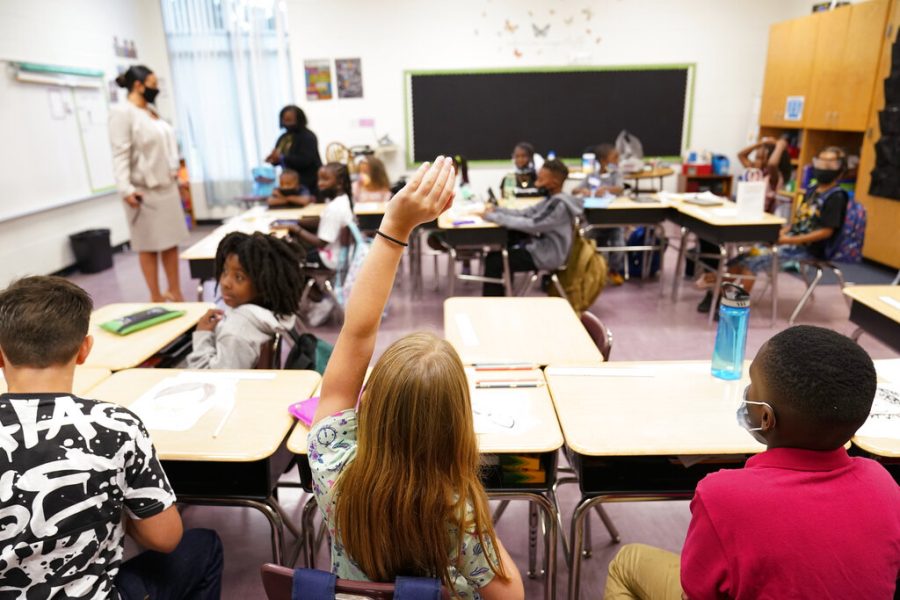OPINION: The fundamental under-funding of public schools
A student raises their hand in a classroom at Tussahaw Elementary school on Wednesday, Aug. 4, 2021, in McDonough, Ga. Schools have begun reopening in the U.S. with most states leaving it up to local schools to decide whether to require masks. (AP Photo/Brynn Anderson)
Opinions expressed in the Op/Ed section of The Knight Crier are not necessarily reflective of the views of the entire staff of the KC.
Across the nation, the amount of money a school gets is related to a number of different factors: the bracket the local taxes are in, how much teachers are getting paid, and how much support they are getting from their individual state and the federal government. However, this is not enough for certain locations.
According to the Century Foundation, most public schools in America are collectively underfunded by about 150 billion dollars every year. Almost ⅔ of the nation’s schools face a “funding gap,” meaning they are not receiving the amount of money they need in order to achieve a flourishing school year.
“Your education is contingent upon your zip code” is a popular saying in Pennsylvania and reflects how not all kids are able to get the same opportunities within the same state.
So why is this happening?
One blatantly obvious reason is that the money is going to other resources. About 75% of a school’s budget is used for teachers’ salaries and benefits. In addition, pieces of it are regularly used in order to pay off debts, which are paying back borrowed money for large products.
“The other 20% is everything else. Anything that the district buys, supplies, textbooks, utilities, transportation, insurance— anything other than people and debt is covered by that 20%. So, when you look at it from that perspective, it’s a really small portion,” Chief Financial Officer of the North Penn School District Mr. Stephen Skrocki explained.
The North Penn School District is on the fortunate end of this spectrum, with a budget of over 200 million dollars. Real estate taxes from businesses help support and add revenue to the district’s budget.
That does not mean certain aspects of the school are not neglected.
How much money the special education program as well as the community’s retirement is not receiving, and how much money the charter schools are receiving has been a large focus within the district.
“Special Ed. for example, started off in the federal government in the 1970s promising to pay for the Individuals with Disabilities Education Act. They promised to pay up to 40% of the costs, to split it up and pay for special education students. They never provided more than 20% of the funding and right now, they are down to about 16%. So, while the costs of special education are increasing, and the funding from the federal government is decreasing, ” North Penn School Board Director Ms. Tina Stoll explained.
Moreover, cyber charter schools have a budget of 500 million dollars but do not have any infrastructure. Whether that money is going directly back into the district, and if it really benefits the students is a mystery. This highlights the fight for charter school reform. People across the local area such as members of the school board, state representatives, and senators are coming together to prioritize which districts really need more money.
“That is another thing that gets stuck in the State and the Senate and it just does not get any further,” Stoll added.
However, schools in close proximity are facing much more serious funding issues. These districts do not have the ability to pick and choose what they spend their money on. Their main concern is making sure that the schools are functioning properly. They do not have the budgetary space to think about providing abundant resources.
“School districts that do not have a commercial tax base really struggle because the state [they are in] does not keep up with its fair share of subsidies of the school district. If you are in a district with more residential properties, you may not have the financial resources to have strong programs like North Penn,” Skrocki said.
Ways that this may be able to change is by reaching out to legislators themselves. Students, families, or really anybody can reach out to these people and advocate for better funding of public schools not only in their local area but the entire nation.


